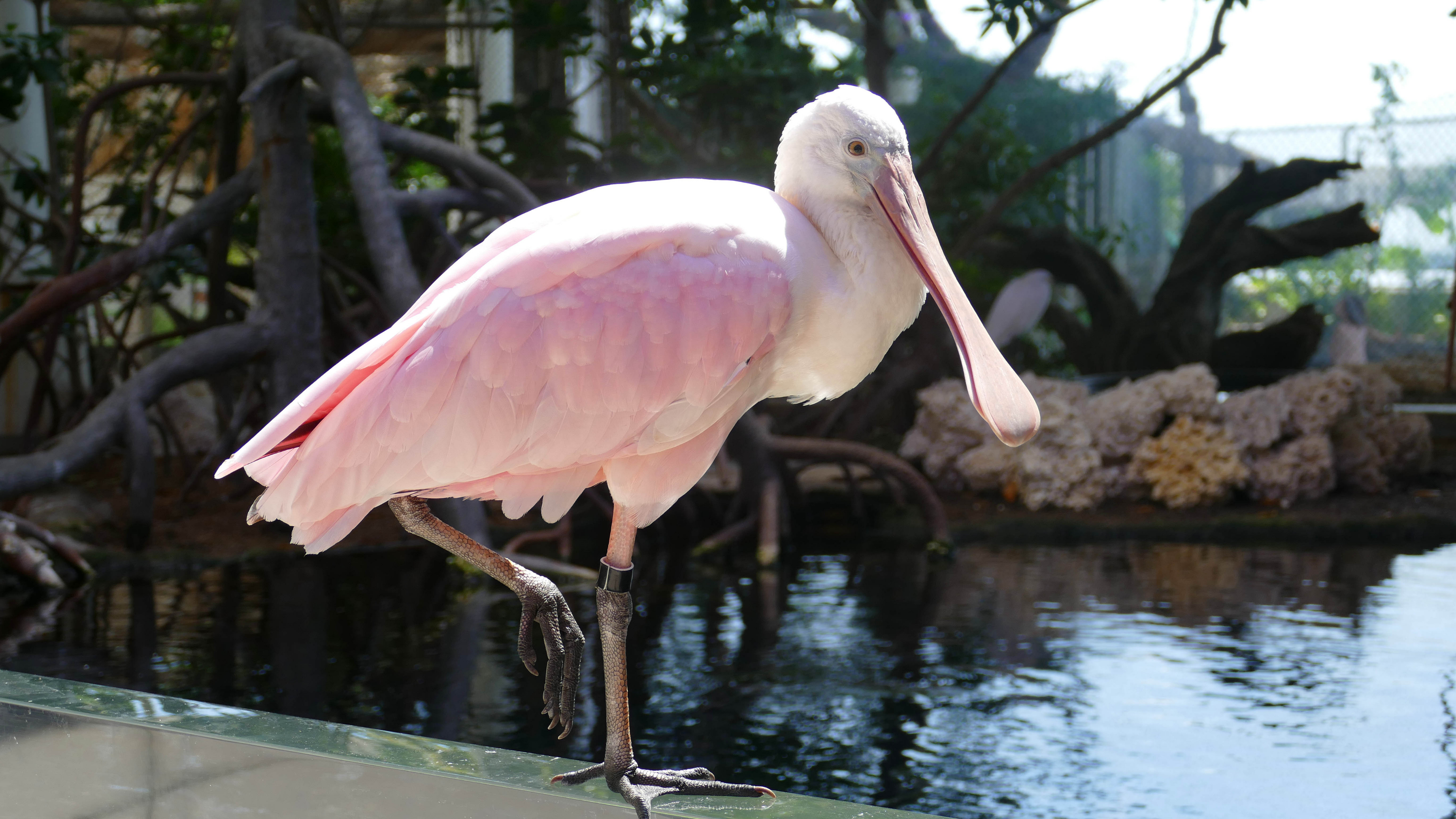
From feathers to scales, Frost Science is home to an array of animals whose unique skin helps them find food, avoid predators, attract mates and live in some of the toughest places on Earth. To celebrate the opening of our new special exhibition, Skin: Living Armor, Evolving Identity presented by Miami Cancer Institute, part of Baptist Health, we’re taking you on a tour of some of our favorite animals throughout the museum and providing some fun facts about their unique skin.
Hammerhead Shark Skin Helps Paleontologists Solve Ancient Mysteries
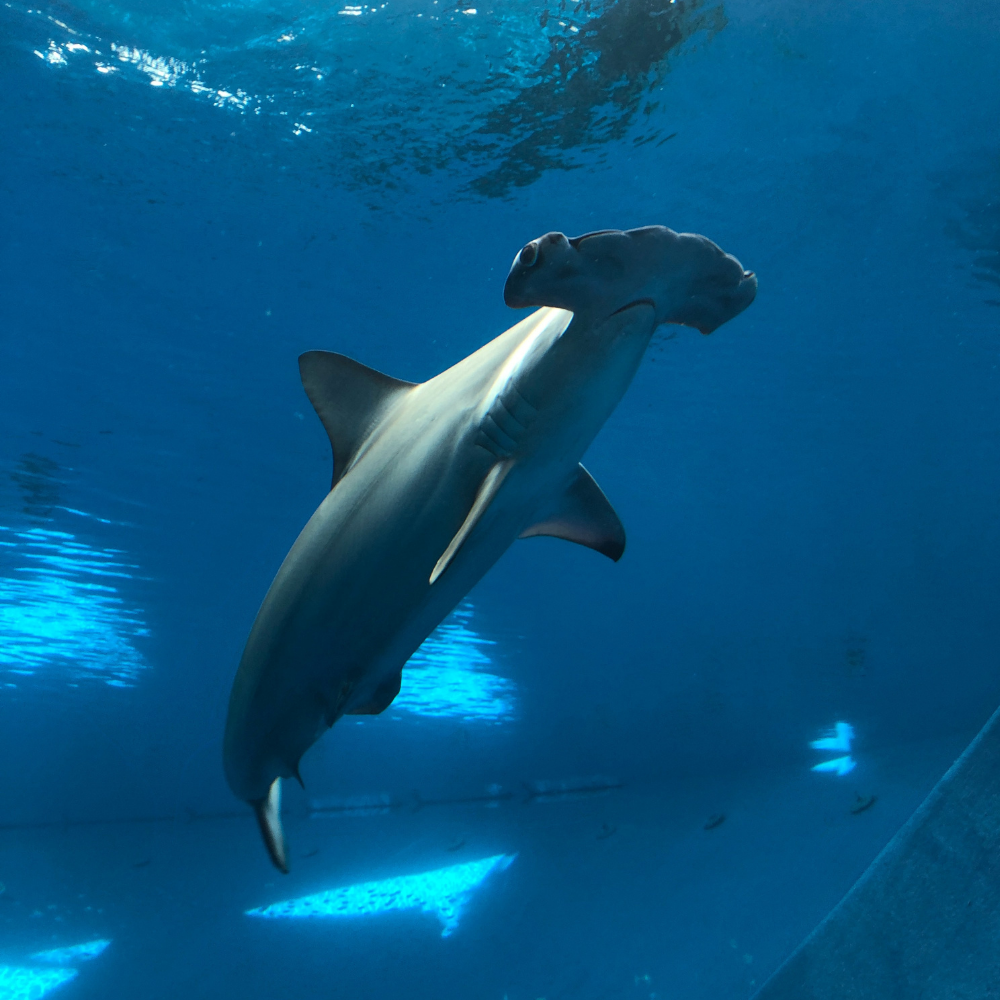
If you’ve watched our hammerheads and silky sharks move about in our Gulf Stream Exhibit, you’ve probably observed that they move quickly. Maybe too quickly for your liking. While sharks have many adaptations for being effective predators, their skin is crucial for helping them swim efficiently. If you’ve braved touching a shark, you’ve probably felt the dermal denticles, or scales, on a shark’s skin. These small denticles overlap so that they feel smooth when stroked in one direction and like sandpaper in the other. This special orientation decreases drag and reduces turbulence, giving the sharks speed and stealth.
For paleontologists, the tooth-like denticles also contain the key to an ancient mystery. When you think about shark fossils, you’re probably not thinking about fossil skin, but the mineral component of dermal denticles mean that they are a common paleontological find. Scientists can also use denticles to gain new insights about shark evolution, which is crucial for understanding a lineage that’s almost 400 million years old. One recent study analyzed the number of denticles at various points in the fossil record and found that sharks nearly went extinct 19 million years ago. While researchers are still trying to understand why such a massive extinction occurred, it’s just one of the many evolutionary questions that can be answered by analyzing a shark’s skin.
Spoonbills Take ‘You Are What You Eat’ to New Levels
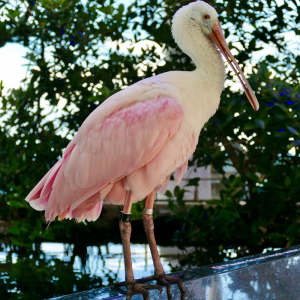
It is hard to miss the roseate spoonbills at Frost Science. You can find them inside the Mary M. and Sash A. Spencer Aviary on The Vista level of the Aquarium. From Rosy, the animated spoonbill in the interactive River of Grass exhibition, to the adult spoonbills found in our aviary, these animals stick out for their namesake spoon-shaped bills and striking pink plumage. Feathers, an important part of the bird’s skin, are not just important for flight, but can help birds stay camouflaged, keep dry and show off to potential mates. As spoonbills become more brightly colored during breeding season, scientists hypothesize that attracting mates might explain why these animals think pink.
Of course, to produce the vibrant pink color, spoonbills need a little help from their prey. Spoonbills, like flamingos, turn pink from a diet of crustaceans, especially shrimp. Crustaceans eat algae that have carotenoids, or pigments that produce reddish colors and give shrimp their pinkish hue. When spoonbills eat these shrimp, their digestive systems help break down the carotenoids into pigments and deposit them in their feathers and skin. Because spoonbills eat different types of animals in different locations, the color of their plumage can vary based on location.
Not Just Crocodile Tears: Crocodiles are Incredibly Sensitive
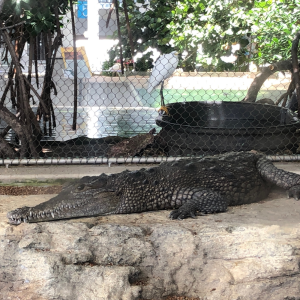
The ranges of American crocodiles and American alligators only overlap in one part of the world. Normally, the freshwater-dwelling alligator and the saltwater-loving crocodiles live in different habitats, but in the brackish waters of South Florida both animals find a home. That’s why at Frost Science, we have both species on display in the Aquarium, showcasing the adaptations of a lineage that has thrived for 200 million years.
As members of such a long-surviving group, alligators and crocodiles have multiple adaptations in their skin, including flaps that make their eyes and ears watertight when diving and armored scales that protect the skin and avoid water loss. Don’t let the rough texture of their skin fool you, though. Crocodile and alligator skin is highly sensitive, with some estimating it can detect sensations so slight that even a human fingertip would miss.
Their secret? If you’re daring enough to look at our crocodile up close, you might discover the answer.
Crocodiles have about 9,000 small black domes over their face and body that are visible to the human eye. These integumentary sense organs can detect tiny changes in heat, pressure and touch, providing crocodiles with ample information about their surroundings. Alligators and caimans also have these sense organs, though only in their skulls. All these reptiles use their sensitive skin to detect the movement of prey and quickly respond. In experiments conducted by scientists, the ripple of a single drop of water several feet away was enough to trigger a reaction from these highly sensitive organs. While these new discoveries suggest you’ll never be able to sneak up on a crocodile, they do provide insight into understanding how these ancient creatures may have adapted to their environments.
Octopus Dreams: Not Just a Pigment of the Imagination?
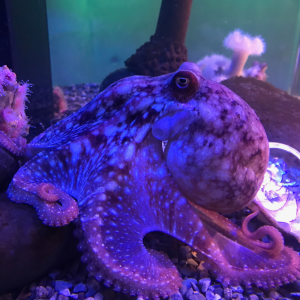
Many animals use camouflage to help them blend into their surroundings, but the octopus takes it to the next level. Octopuses – like our Pacific red octopus located within on The Dive level of the Aquarium – can change the color and texture of their skin almost immediately. To do this, octopuses rely on chromatophores, or color-changing cells, that expand or contract to change the amount of pigment displayed on their skin. An octopus may use this color-changing ability to protect itself from predators, catch prey or warn other animals to stay away.
Though scientists have long known octopuses were intelligent, recent studies have potentially connected their color-changing abilities to a hallmark of animal intellect – dreaming. Octopuses cycle between two types of sleep: passive and active. During active sleep, which only lasts about 40 seconds in an octopus, the animal will rapidly move its eyes, change textures and dramatically flash between different colors. If this active sleep serves the same function that it does in humans and other intelligent mammals, this is probably a time when the octopus is organizing its brain, storing important memories and discarding unimportant ones. It’s too early to conclude that the octopus can dream like a human, but it shows the power of skin in helping scientists understand complex animal behavior.
Sea Star Skin Holds a Clue for Stopping Wasting Disease
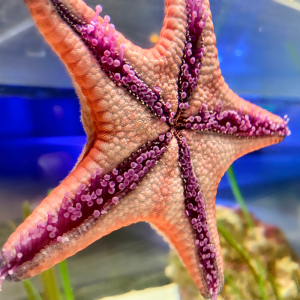
All animals need oxygen to survive, and sea stars are no exception. While land-dwelling animals use their lungs to breathe oxygen-rich air, sea stars and other marine creatures take in oxygen from water. Sea stars absorb oxygen-rich water through skin gills located on the top of the animal.
Recently, researchers discovered a connection between the need for oxygen and sea star wasting disease. This epidemic, which has decimated sea stars on both coasts, gradually causes the animals to lose their limbs and, eventually, turn to goo. Though at first a virus was thought to be responsible, researchers now think that bacteria that dwell in warm water may also contribute. Rather than infecting the sea stars, these bacteria instead take up much of the existing oxygen in the water, making it hard for the sea stars to breathe. Sea stars left in this environment will eventually “drown” from lack of oxygen. Climate change and rising ocean temperatures make these bacteria more abundant. Though sea star wasting disease continues to pose a threat to these animal’s survival, knowing the cause can help scientists develop more effective treatments and help restore existing populations.
Horseshoe Crab Skin Helped Them Survive for Hundreds of Millions of Years
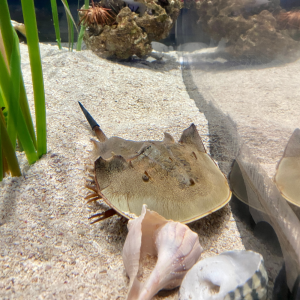
Take a visit to our Dive Bar and you might discover one of the longest living animal lineages: the horseshoe crab. Though horseshoe “crab” is a misnomer – they are more closely related to scorpions and spiders – these invertebrates have existed almost unchanged since the Ordovician period, 480 million years ago. Despite not being closely related to humans or mammals, studying their unique adaptations have led to many innovations in human medicine, most recently in assisting with the development and testing of the COVID-19 vaccine.
Like many other arthropods, horseshoe crabs are covered by a hard carapace that offers protection from predators. As horseshoe crabs grow, they must shed this carapace, leaving behind a ghost-like molt. Horseshoe crabs will molt up to six times during their first year of life, then average about one molt a year until they reach adult size. Unlike many other invertebrates that grow up quickly, horseshoe crabs won’t reach their full adult size until at least nine years of age and may live to 20 years of age. These intriguing animals have evolved unique strategies to survive, virtually unchanged, for hundreds of millions of years, in their skin and throughout their bodies.
Turtle Shells are a Unique Adaptation of Skin and Bone
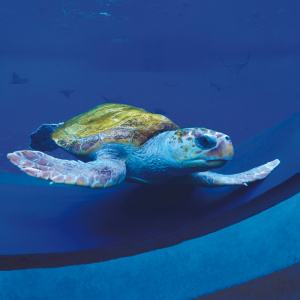
If you time your photo at our iconic Oculus lens just right, you might just be photo-bombed by a loggerhead turtle. Miko, a 200 lb. rehabilitated sea turtle, is a favorite of our Gulf Stream Exhibit and spends much of her day lurking near the bottom of the habitat or feasting on her diet of fish and squid.
When you think about the skin of Miko or any other turtle, it’s hard not to first think of the shell. The turtle’s shell is largely made of bone, specifically modified spine and rib bones. While the bony parts of the shell are not technically skin, this bone is covered by large keratin scales, called scutes, which are part of the turtle’s skin. Together the bone and scutes make up the heart-shaped carapace of Miko and other loggerheads. While not all aquatic turtles have the same shell shape, they do differ from their terrestrial relatives. The shells of land-dwelling turtles tend to be higher and more dome-shaped, while aquatic turtles have more sleek and low shells that may reduce water resistance while swimming.
The scutes of turtles also differ between terrestrial and aquatic turtles. While land-dwelling turtles will grow their scutes throughout their lifetime, aquatic turtle will shed their scutes, sometimes as often as once a year. Though scientists have observed this phenomenon for centuries, they still don’t know exactly what makes aquatic turtles adopt this behavior, but some hypothesize that it might be to streamline shell shape or get rid of the algae that might grow on the shell.
Human Skin Carries Remnants of our Evolution

Finally, we want to highlight the amazing adaptations of the human animals that you might encounter during your visit to Frost Science. At first glance, human skin is pretty boring. It doesn’t have the colorful feathers or bony scales of some of the other animals we’ve discussed. However, from an evolutionary perspective, human skin is unique. Humans are among the only mammals without dense fur covering most of their bodies, an important adaptation to help humans sweat and shed heat during the hottest parts of the day. If you are visiting us on a particularly hot and humid day in South Florida, you’ll likely be glad of your human adaptation to efficiently cool off.
Since losing our hair happened recently from an evolutionary perspective, humans still retain some of the adaptations that helped when we were slightly hairier. One of our favorites are goose bumps, which humans can get when we are cold, scared or even when we hear emotionally moving music. A personal music guide probably wasn’t their focus in evolution though. Goose bumps occur when adrenaline causes a tiny muscle just barely under the skin contracts – to literally make your hair stand on end. It happens in other animals too – and it helps them stay warm by puffing up their hair and creating a protective barrier. Even the hairiest of us probably can’t draw much warmth from the little hair covering we have left, but I bet deep in evolutionary history, it would have made cold weather much more tolerable. Our evolutionary history is literally written upon our skin. It’s enough to give you, well, goosebumps.
Has hearing about all these amazing creatures gotten under your skin? Then you can visit us in person to check out these animals and more along with visiting our new Skin: Living Armor, Evolving Identity special exhibition presented by Baptist Health’s Miami Cancer Institute on display from Friday, October 8, 2021 through Sunday, April 3, 2022 inside the Hsiao Family Special Exhibition Gallery on the first floor of the museum. Admission to Skin: Living Armor, Evolving Identity is included with all museum admission tickets.
Skin: Living Armor, Evolving Identity was created by the California Academy of Sciences and modified for travel and distributed by the Science Museum of Minnesota. The exhibit is generously supported by Susan and Nicholas Pritzker and Family.